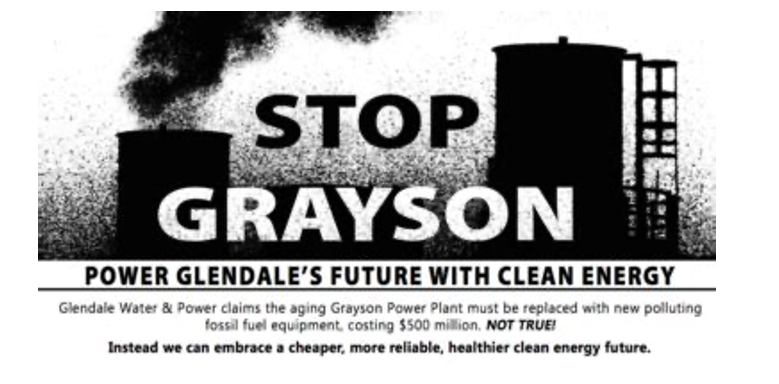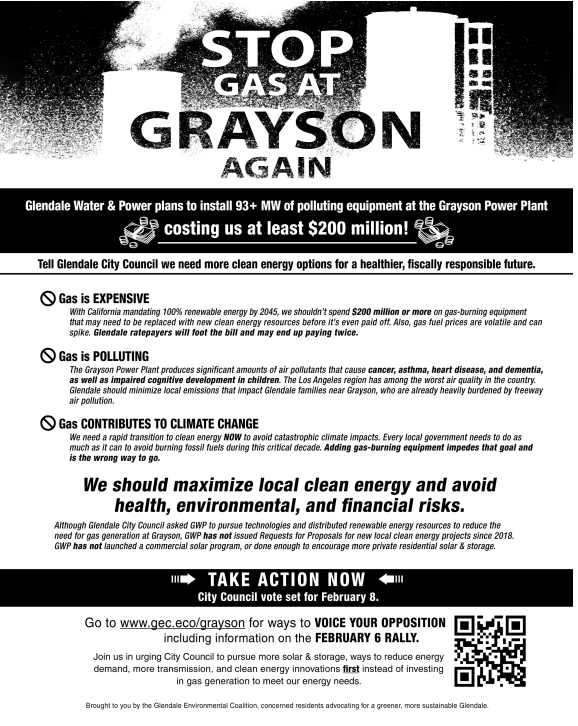CommentsCOMMENTARY - The Glendale Water & Power (GWP) folks are back and just as bad as ever.
Not content with bamboozling their City Council into allowing them to continue pursuing the gas generation plant at the Scholl Canyon dump, the resurrected Grayson Repowering Proposal, shut down by activists in 2017 is up for another vote on February 15.
After the denial of the 2017 plan, Glendale City Council directed GWP to develop a plan to transition to 100% clean energy by 2030. This could have included prioritizing locally distributed solar and storage, improved demand response and load flexibility, peak load reduction strategies, and implementation of energy efficiencies and other sustainable practices.
However, by the end of 2021, it was clear that GWP had simply paid lip service to the Council’s requests, and have come back with two equally poor choices, albeit with reduced output: five new internal combustion engine units or refurbishing two of the existing Grayson turbines.
Additionally, in five years Glendale will start receiving almost as much power as either of these would provide on its Southwest Transmission Line. Despite this, the proposal remains the same.

The Economic Impact
This new and “improved” proposal would still commit Glendale residents to hundreds of millions of dollars invested in a fossil fuel facility at a time when most of California is moving towards 100% clean energy. Glendalians already understand the dangers of climate change and many are taking measures to conserve so they are likely to require less, not more, power in coming years.
With three members of the Glendale City Council – Ardy Kassakhian, Paula Devine and Dan Brotman – having been endorsed by the Glendale Environmental Coalition, one would hope this new Proposal would be given the boot, but there’s a potential conflict of interest.
Since GWP is planning to generate far more than Glendale needs, the obvious implication is that it is choosing to create excess to provide for sales opportunities. If their city is facing fiscal challenges like Los Angeles, the City Council may view this as a prospective solution to balancing the budget.
However, when the cost of fuel at today’s prices is considered, the Glendale taxpayers will be faced with footing a fuel bill of possibly twice the construction cost, a cost that will be added to the financing of the plant itself and extracted from their utility bills over the next 30 or 40 years.
There is increasing pressure to shut down the Aliso Canyon storage facility after a gas leak in 2015 released 110,000 pounds of methane per hour poisoning people and pets and leading to the eventual evacuation of nearby Porter Ranch.
Earlier this week the Los Angeles City Council passed a motion to phase out all oil and gas extraction within the City limits, and increasing pressure is being brought to bear on Sacramento to shut down all fracking operations in the State.
Everyone – GWP, Glendale City Council and Glendale utility users – needs to acknowledge that the price of natural gas will probably surge significantly over the next few years making GWP’s proposal increasingly cost-prohibitive.
And when gas prices spiked in years past, GWP shut Grayson down for months to save money. How much does Glendale want to pay for this white elephant?
In comparison, solar has virtually zero fuel costs, lower maintenance, and far fewer toxic side-effects. Google's Project Sunroof shows Glendale has the potential for up to 400 megawatts of photovoltaic solar on existing rooftops plus another 75 megawatts if the Scholl Canyon landfill were to shut down.
If the GWP thought that up to 75 MW of back-up power in summer months and 25 MW in winter months from the LADWP would be adequate during the three-year shut-down under their 2018 plan, why the hell are they pushing their current repowering scheme?
North America’s largest utility, the Los Angeles Department of Water and Power has listened to the people of Los Angeles and put a hold on new gas-fired plants is working on expanding clean energy alternatives.
The second largest utility which serves the Toronto area in Ontario, Canada, is looking to upend the traditional power distribution model by moving to micro-grids and intelligent solar-plus-storage systems creating a more sustainable, reliable model of doing business through innovation, improving efficiency and saving costs.
The Environmental Impact
The Grayson power facility is located near San Fernando Road and Flower, northeast of the 134 and 5 freeway interchange, beside the L.A. River, and across from the John Ferraro Athletic Fields in Griffith Park.
Approving the Repowering will ensure Glendale will continue to emit greenhouse gasses including dangerous amounts of carbon monoxide (CO), sulfur oxide (SOx), nitrogen oxide (NOx), particulate matter (PM2.5 and PM10) and other harmful chemicals into adjacent communities.
Unless stopped, these will impact homeowners and renters, schools and businesses, in and adjacent to Glendale, Los Feliz, Northeast Los Angeles, Pasadena and Burbank as well as in Griffith Park, along the LA River corridor and at the LA Zoo at a time when California has committed to cutting emissions to 40% below 1990 levels by 2030.
Furthermore, the Grayson plant sits in a mapped California Liquefaction Hazard Zone which means the site may be susceptible to seismically induced liquefaction in the event of a major earthquake, leading to a real risk of ruptured pipelines causing gas leaks or sudden explosions putting sections of Glendale, Burbank and Los Angeles at further danger in such an event.
Environmental groups including the Glendale Environmental Coalition and the Sierra Club are calling on the Glendale City Council to again reject GWP’s proposal in favor of clean air and green energy.
The Council’s smartest move would be to force GWP to join the 21st century by returning to the drawing board and looking at truly renewable energy solutions for Glendale.
As an added bonus, if they put the kibosh on the Grayson expansion, they can save the citizens of Glendale more millions on the Scholl Canyon boondoggle, the dangerous and wasteful Biogas Renewable Generation Project, and use the funds for needed remediation so that residents can once again enjoy their piece of southeast Glendale.
Glendale stakeholders have more skin in the game financially and may have more clout but, since airborne pollutants don’t recognize city boundaries, we are all stakeholders in this.
Please contact the Glendale City Council before the vote on Tuesday, February 15:
and the GWP Commissioners at [email protected]
You can find information on attending the meeting and giving public comment on the Glendale Public Meeting Portal.
And if you want the exercise, you can RSVP for the Glendale Environmental Coalition’s in-person rally at Glendale City Hall on Sunday, February 6 at 3 pm here.
(Liz Amsden is an activist from Northeast Los Angeles with opinions on much of what goes on in our lives. She has written extensively on the City's budget and services as well as her many other interests and passions. In her real life she works on budgets for film and television where fiction can rarely be as strange as the truth of living in today's world.)







